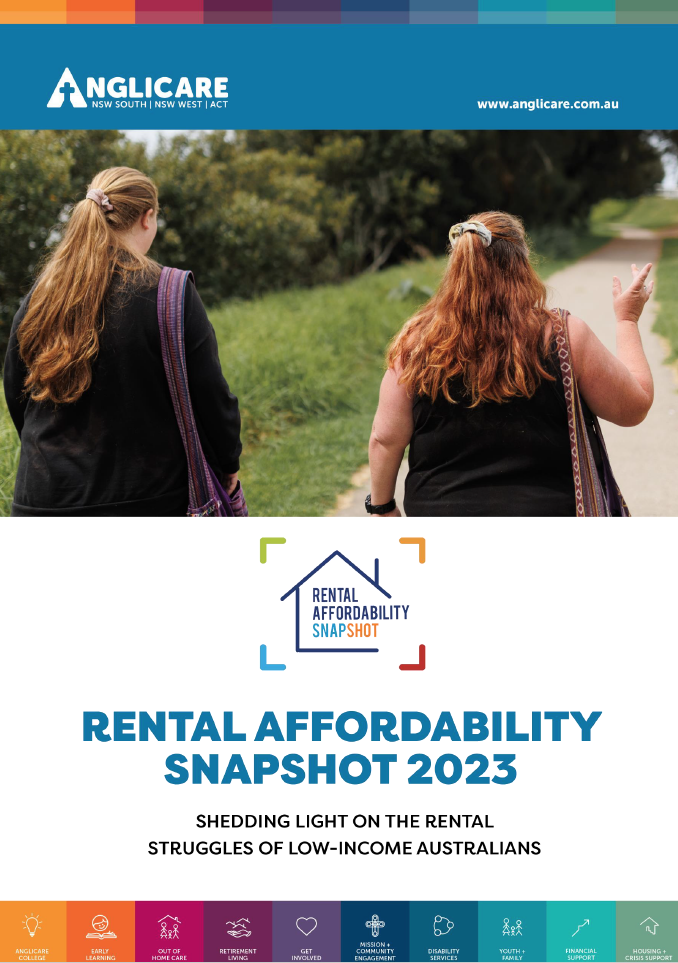Statistics from Anglicare’s Rental Affordability Snapshot, released this week, confirm that unprecedented rental rate increases over the past few years have culminated in a devastating reality for people surviving on low incomes.
The Snapshot, which Anglicare releases annually, evaluates the private rental market to determine the affordability and appropriateness of rental properties for households on low incomes by taking a snapshot of rental properties listed on realestate.com.au, allhomes.com.au, and gumtree.com.au on a single weekend (18-19 March, 2023).
This year’s Snapshot showed that in the ACT and Queanbeyan 0-1% of rental listings were appropriate and affordable for households surviving on income support payments, with 0-2% for households earning minimum wage.
ACT’s median weekly rental rate of $625, representing 72-222% percent of income for those receiving income supports.
For example, median rental costs in the ACT require 119% of income for both single pensioner households and single disability support pension households. While, for a single person on JobSeeker, the median rent as a share of income in the ACT reached 180%.
In fact, Canberra is the most unaffordable place to live for almost every category of people on low incomes in Australia. The region’s already high rental rates have climbed an additional 20% in the past two years, while vacancy rates remain near 1%.
Gillian Fox has been volunteering with Anglicare at the Gordon Community Centre’s food pantry for over 3 years and says the recent increase in need for emergency food assistance is significant. “People pay their rent and bills first, then have little left over for food” she said. “The group we are seeing impacted the most is single mothers with multiple children”, said Gillian, “followed by aged pensioners, especially those living alone.”
Many of the vulnerable individuals and families seeking assistance in the ACT and Queanbeyan are working and earning minimum wage, but the high cost of housing means prioritising rent over other essential expenses like food, utilities and healthcare which has created a surge in need for emergency relief services.
Gillian recently provided emergency food relief to a grandmother whose adult daughter passed away suddenly. “She came to us for food”, said Gillian, “but she was also dealing with grief and the new responsibility of raising a young child on her own. She also had the stress of knowing that without her daughter’s income she could no longer afford the rent.”
While Gillian was able to provide the woman and child with immediate food assistance, vouchers for fuel, connection to a Chaplain for grief support and provide referrals to housing services, there was little to be done about her immediate housing situation. With limited social housing, the current average wait time is 5 years in the ACT.
The shortage of affordable rental properties has significant implications, leading to overcrowding, homelessness, unemployment or financial hardship. Research shows that single-parent families and women with children experiencing violence are particularly vulnerable, the latter making up 42% of Specialist Homelessness Services clients in 2020-21.
The Snapshot reveals that in the ACT and Queanbeyan, 0% of listings are appropriate and affordable for such single parent families, whether on income support or earning minimum wage.
“In the 14 years Anglicare has produced the Rental Affordability Snapshot, we have never seen an outlook as dire for our vulnerable community members”, said Anglicare CEO Brandon Howard. “We are fortunate in the ACT to have some of the most protective rental legislation in the country, including the recent ban on no-cause evictions. We also appreciate proposed measures such as a Rent Relief fund and targeted tax concessions for investing in new rental dwellings. However, these solutions are not keeping pace with the range of pressures affecting the housing security of low-income Australians.”
While not for profits like Anglicare can provide relief and essential support for those in need, the severity of the current housing crisis will require meaningful solutions from local and federal governments.
With significant spikes in demand for our Emergency Relief services since December 2022, Anglicare sees an increase in funding for specialist crisis and homelessness services as essential to support those who have been displaced and are struggling to secure housing.
To read the full report and see stats for ACT and regional NSW, CLICK HERE or click the image below.
